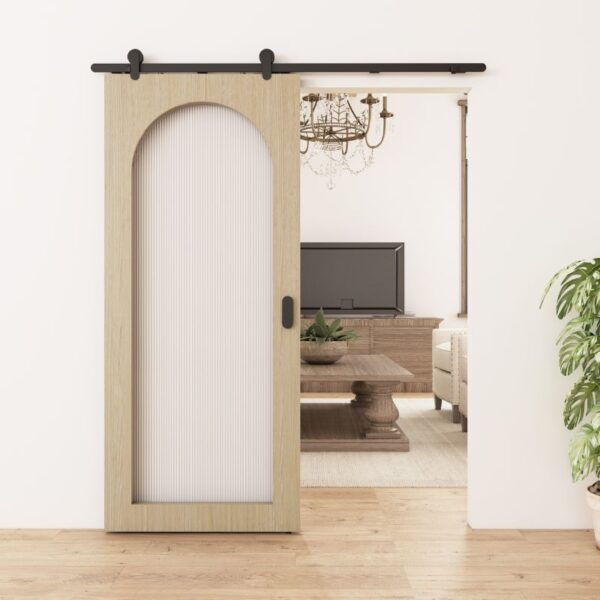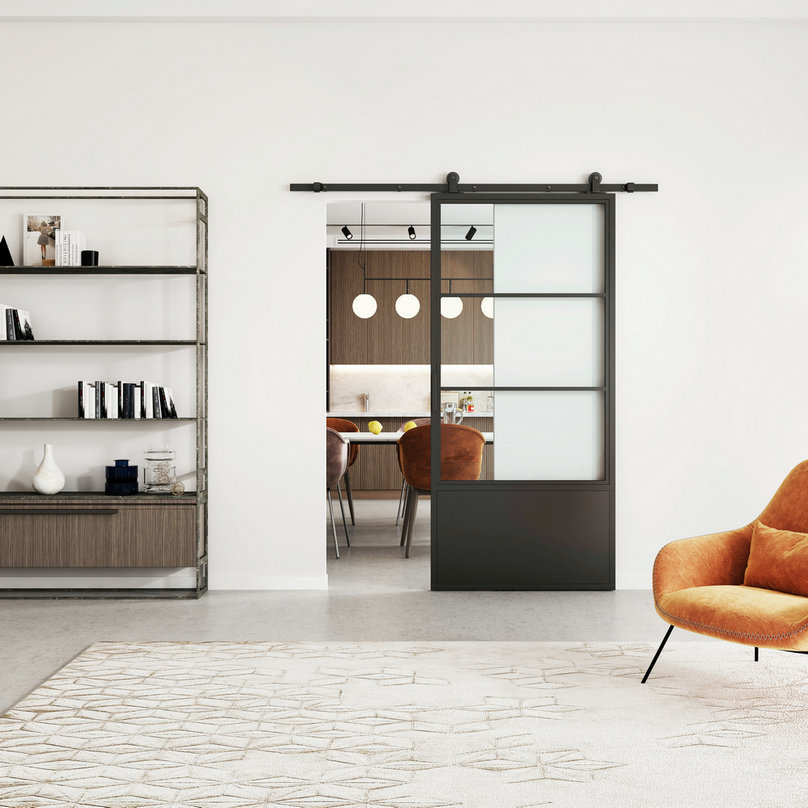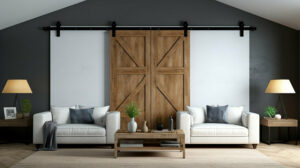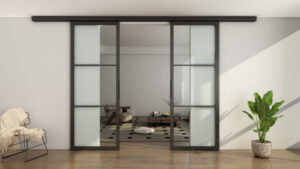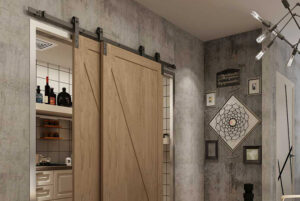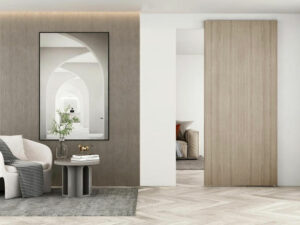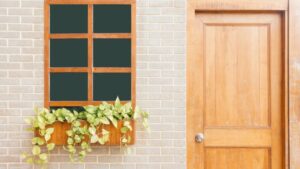In design, texture refers to the surface quality of a material. It’s how something looks and feels, and it falls into two primary categories:
- Tactile Texture: This is the literal feel of a surface. It’s the coarse reality of a brick wall under your fingertips, the cool, smooth slide of a marble countertop, or the comforting softness of a velvet cushion.
- Visual Texture: This is the illusion of texture. A surface can be completely smooth to the touch but still have immense visual texture. Think of the intricate grain of a wood veneer, the detailed pattern on a piece of damask wallpaper, or a photograph of a sandy beach.
The Importance of Texture to Transform Your Space
Texture is far more than just a finishing touch; it’s a foundational element that adds critical layers of interest and sophistication to a design.
Creating Emotional Responses
Texture has a powerful psychological impact. Soft, plush textures like cashmere throws and chunky knit blankets can make a space feel like a cozy, warm embrace. In contrast, sleek materials like polished chrome and glass evoke a sense of modernism and sophistication, while the ruggedness of hewn wood and natural stone can ground a space with rustic authenticity.
Enhancing Aesthetic Appeal
A room without varied textures can feel flat, dull, and visually uninteresting. Texture adds depth and dimension, creating what designers call “visual weight.” It catches the light in different ways, creating subtle highlights and shadows that make a space feel dynamic and alive. A mix of rough, smooth, soft, and hard surfaces ensures the eye has a rich landscape to explore.
Adding Character and Personality
The textures you choose are a direct reflection of your personal style. Are you drawn to the rustic charm of reclaimed wood and raw linen? The glamorous allure of velvet and silk? The earthy, bohemian vibe of rattan and jute? Your textural palette tells a story, infusing your home with a unique personality that is distinctly yours.
Complementing Other Design Elements
Texture works in harmony with every other element in a room. It can enhance a color scheme, especially a monochromatic one, by adding variation and preventing it from feeling monotonous. It also provides balance; for example, the hard lines of a modern sofa can be softened with plush pillows and a chunky knit throw, creating a more inviting and balanced composition.
Main Types of Texture in Interior Design
To build a rich textural landscape, you need a diverse palette of materials. Here are the key types to know.
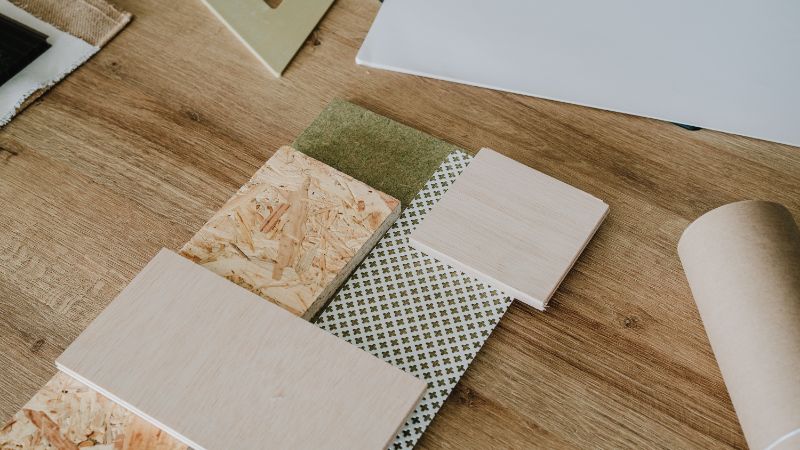
1. Soft Textures
These are the textures of comfort and luxury. Think of materials like velvet, chenille, wool, faux fur, and soft linens. They absorb sound, which creates a quieter, more intimate atmosphere. Use them generously in places meant for relaxation, such as upholstery, pillows, throws, drapery, and rugs.
2. Hard and Rough Textures
To provide balance to soft surfaces, every room needs hard or rough textures. Materials like reclaimed wood, exposed brick, concrete, and natural stone add a grounding, organic element. They can feel rustic, industrial, or elegantly natural, providing a solid foundation for your design on accent walls, flooring, fireplaces, and countertops.
3. Metallic Textures
Smooth, sleek, and reflective, metallic textures bring a touch of glamour and modernity. Polished chrome, brushed brass, stainless steel, and copper bounce light around a room, making it feel brighter and more spacious. They are perfect for lighting fixtures, cabinet hardware, furniture legs, and decorative accessories.
4. Natural Textures
Materials derived from nature, such as rattan, jute, seagrass, wicker, and bamboo, bring an earthy and calming vibe indoors. Their often-imperfect, woven surfaces add a layer of handcrafted character, making them ideal for creating a relaxed, bohemian, or coastal aesthetic in chairs, rugs, light fixtures, and baskets.
5. Patterned Textures
Texture isn’t just tactile; it can also be purely visual. Patterns—from bold geometric prints to delicate florals or classic herringbone—create the illusion of texture. They can introduce energy, elegance, or whimsy into a space and are incredibly versatile, working well on wallpaper, tiles, textiles, and rugs.
How to Use Texture in Interior Design
Knowing the types of textures is the first step. The art lies in how you combine them.
1. Creating Contrast
The most effective way to make textures stand out is to create contrast. Pair opposites to highlight their unique qualities. Place a smooth, glossy vase on a rough, wooden table. Lay a soft, sheepskin rug on a polished concrete floor. Juxtapose a sleek leather armchair with soft linen curtains. This push-and-pull makes each element more impactful.
2. Layering Different Textures
Layering is the fundamental technique for creating a rich, designer-quality look. Build your room in textural layers. Start with a foundational texture on the floor, like a wood floor or a low-pile rug. Add a large piece of upholstered furniture. Then, layer on smaller items: pillows in different materials, a soft throw blanket, and curtains. This gradual build-up creates a cohesive and deeply inviting space.
3. Crafting Focal Points
Use a bold, high-contrast texture to create a stunning focal point. This could be a dramatic accent wall covered in textured wallpaper, exposed brick, or Venetian plaster. A large, vibrantly patterned area rug or a statement piece of furniture upholstered in a rich velvet or boucle can also serve as the textural centerpiece of a room.
4. Defining Zones and Functions
In open-plan living, texture is an excellent tool for delineating different zones. A large, plush rug can instantly anchor a living area and separate it from a dining space, which might be defined by the smooth surfaces of a wooden table and leather chairs. This creates a sense of order and purpose without the need for walls.
5. Adding Character and Style
Finally, use texture to reinforce your chosen design style.
- Modern Farmhouse: Combine rough-hewn wood and blackened metal with soft cotton and linen textiles.
- Glam/Art Deco: Lean into luxurious velvets, silks, and high-shine lacquers and metals.
- Minimalist: Focus on a subtle mix of warm woods, smooth concrete, and natural textiles like linen and wool.
- Bohemian: Freely mix natural textures like rattan and jute with macrame, patterned textiles, and lots of plants.
By consciously selecting and combining textures, you can craft a home that not only looks beautiful but feels truly personal and alive.
Opening the Door to Texture: The Role of Interior Doors
Often overlooked, an interior door is a powerful design element—a vertical plane that can contribute significantly to a room’s overall texture profile. It’s far more than a simple passageway.
Wood Grain:
Classic and warm, wood grain adds natural texture. A prominent grain like oak feels rustic and traditional, while a finer grain like maple or birch offers a more subtle, modern effect.
For a beautiful wood-grain look, explore Tengyu’s Paint-free Doors which offer the appearance of wood without the maintenance.
Painted Finishes (Matte vs. Gloss):
The finish of a painted door is a textural choice. A smooth, matte or eggshell finish provides a modern, understated texture that absorbs light for a soft look. A high-gloss finish, however, is sleek, reflective, and bold, bouncing light and adding a touch of glamour.
Molded & Paneled Doors:
The dimension created by panels, stiles, and rails is a classic form of visual texture. The interplay of shadows and highlights across the door’s surface adds depth and a traditional feel.
Tengyu offers a variety of Mould Pressed Doors that provide this timeless, textural appeal.
Carved or Fluted Doors:
For a high-impact statement, a carved or fluted door offers intricate, tactile texture. This choice adds a layer of custom craftsmanship and can become a true focal point in a room. Tengyu welcomes custom designs to achieve this unique, high-end look.
Metallic or Inlay Details:
Introducing a contrasting material, such as thin metal strips inlaid into a wooden door, creates a sophisticated, mixed-media texture that speaks to a detailed and luxurious design sensibility.
For a sleek, modern metallic texture, consider Tengyu’s Metal Frame Glass Sliding Doors, which blend the smoothness of glass with the cool, clean lines of a metal frame.
Matching Door Texture to Your Design Style:
- Modern: Look for smooth, flush doors with a clean, unadorned surface, often with a matte or high-gloss painted finish.
- Farmhouse/Rustic: Embrace paneled or barn-style doors with a prominent, natural, or distressed wood grain.
- Traditional: Opt for intricately molded or carved doors that showcase classic craftsmanship and dimensional detail.
Discover Your Perfect Interior Design with Tengyu Doors
At Tengyu, we specialize in crafting doors that serve as key design elements. Whether you are designing a single room or undertaking a large-scale project, our doors can provide the ideal finishing touch.
Your Vision, Our Craftsmanship
Whatever your design needs, Tengyu Door is here to bring your vision to life. Every door we create is fully customizable to your specifications, with no minimum order quantity (MMQ) required.
Feel your way to a beautiful home. Contact us today to learn how Tengyu doors can complete your design.

